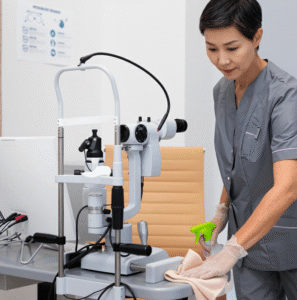Overview
Pituitary apoplexy is a rare but life-threatening medical emergency caused by sudden bleeding (hemorrhage) or impaired blood flow (infarction) in the pituitary gland, usually due to a pre-existing pituitary adenoma. This condition leads to rapid gland swelling, which can compress nearby structures in the brain and drastically reduce hormone production. Immediate medical and surgical intervention is often required to prevent permanent vision loss, neurological damage, or death.
What is Pituitary Apoplexy?
Pituitary apoplexy refers to an acute event involving the pituitary gland, most often in the setting of an undiagnosed or known pituitary tumor. The sudden hemorrhage or infarction disrupts the gland’s function and may lead to compression of the optic chiasm, cranial nerves, and other nearby brain structures.
It can present with dramatic neurological and endocrine symptoms, and may mimic other neurological emergencies like stroke or meningitis. Though rare, early recognition and treatment are crucial for survival and long-term recovery.
Symptoms
Symptoms of pituitary apoplexy develop suddenly and may include:
- Severe, sudden-onset headache (often described as the “worst headache of life”)
- Visual disturbances, including blurred vision, double vision, or vision loss (especially peripheral vision)
- Drooping eyelid or inability to move the eye (cranial nerve palsy)
- Nausea and vomiting
- Altered mental status or confusion
- Neck stiffness or fever (can resemble meningitis)
- Sudden hormonal deficiencies, leading to:
- Low blood pressure
- Fatigue
- Low blood sugar
- Electrolyte imbalance
- Reduced consciousness (in severe adrenal insufficiency)
Causes
Pituitary apoplexy is typically caused by bleeding into or lack of blood flow in a pituitary tumor. Triggers and contributing factors include:
- Undiagnosed or large pituitary adenomas
- Major surgery (especially cardiac or orthopedic procedures)
- Head trauma
- High blood pressure or hypertension
- Bleeding disorders or anticoagulant use
- Pregnancy or childbirth (Sheehan’s syndrome)
- Radiation therapy to the brain
- Dynamic pituitary testing (stimulation tests can occasionally trigger apoplexy)
- Spontaneous cases without any clear cause
Risk Factors
Factors that increase the risk of developing pituitary apoplexy include:
- Existing pituitary macroadenoma (tumor >10 mm)
- Use of blood thinners (e.g., warfarin, aspirin)
- Uncontrolled hypertension
- Recent major surgery
- Head trauma
- Pregnancy/postpartum period
- Radiation exposure to the brain
- Rapid tumor growth
Complications
If not promptly diagnosed and treated, pituitary apoplexy can result in:
- Permanent vision loss
- Cranial nerve damage (leading to eye movement problems)
- Severe adrenal insufficiency, which may be fatal if untreated
- Pituitary hormone deficiencies (panhypopituitarism)
- Chronic headaches or fatigue
- Hypothyroidism, infertility, or loss of sexual function
- Recurrent apoplexy in untreated tumors
- Coma or death in the most severe cases
Prevention
Because pituitary apoplexy often strikes without warning, direct prevention is limited. However, the following can help reduce risk or detect problems early:
- Regular monitoring of known pituitary adenomas
- Surgical removal of large or growing adenomas before complications arise
- Controlling blood pressure and managing chronic conditions
- Avoiding high-risk procedures without endocrine clearance in tumor patients
- Careful use of anticoagulants in patients with pituitary tumors
- Prompt evaluation of sudden headache or vision changes, especially in patients with pituitary disease
Treatment Options in Korea
South Korea is internationally recognized for its advanced neurosurgical and endocrinological care, making it an ideal destination for managing pituitary apoplexy. Emergency treatment typically involves a combination of medical stabilization and surgical intervention.
1. Emergency Stabilization
- IV corticosteroids (e.g., hydrocortisone): To treat life-threatening adrenal insufficiency
- IV fluids and electrolyte correction
- Monitoring of vital signs and neurological status
- Hospitalization in an intensive care unit (ICU)
2. Neurosurgical Treatment
- Transsphenoidal decompression surgery: The standard approach to relieve pressure on the optic chiasm and drain hemorrhage
- Endoscopic techniques: Commonly used in Korea for faster recovery and minimal invasiveness
- Craniotomy: Reserved for rare, complicated cases with widespread bleeding or tumor extension
3. Long-Term Hormonal Management
- Endocrinology follow-up for assessing permanent hormone deficiencies
- Hormone replacement therapy, including:
- Cortisol (hydrocortisone or prednisone)
- Thyroid hormone (levothyroxine)
- Sex hormones (testosterone or estrogen/progesterone)
- Growth hormone (in selected cases)
4. Diagnostic and Monitoring Services
- High-resolution MRI with contrast to assess tumor, bleeding, and brain structures
- Pituitary function testing to determine hormonal deficits
- Ophthalmologic assessments for visual field evaluation
- Multidisciplinary pituitary clinics in top-tier hospitals
5. International Patient Support in Korea
Hospitals such as Samsung Medical Center, Severance Hospital, and Seoul National University Hospital offer:
- Emergency neurosurgery 24/7
- International patient centers with English-speaking coordinators
- Advanced MRI, neuroendocrinology, and ICU care
- Long-term outpatient hormonal follow-up and support
With fast access to specialized care, modern surgical techniques, and coordinated recovery planning, Korea is among the best countries in the world for managing serious conditions like pituitary apoplexy.













